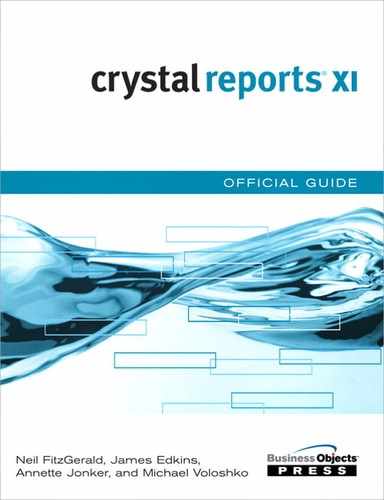Introduction
In this introduction
Introduction to Information Delivery 2
Spectrum of Business Objects Product Usage 3
The Product Family from Business Objects 8
Equipment Used for This Book 13
Introduction to Information Delivery
Organizations today of all sizes find themselves increasingly awash in data yet hungering for information to help them meet their business objectives. These corporations, from Main Street and Wall Street alike, have spent large amounts of time and money over the past 10 or so years implementing systems to help collect data on and streamline their operations. From monolithic Enterprise Resource Planning (ERP) systems (SAP, PeopleSoft, Oracle, and so on) through Customer Relationship Management (CRM) systems (Siebel, Pivotal, Salesforce.com, and so on) to Custom Data Warehousing projects, these firms are now looking for ways to extract value from that collective body of data to help them run their businesses more productively and competitively. These firms are looking for a strategic information delivery or business intelligence solution to help them become more productive and ultimately compete more effectively. The products covered in this book are geared toward meeting that challenge.
The information delivery products and solutions that are presented in this book are often categorized under the Business Intelligence (BI) banner. BI is the industry of value-added information delivery based on structured data sources—essentially providing meaningful, business-driven value and information to business end-users by connecting them to data with appropriate tools and products. Figure 0.1 highlights the conceptual divide of Information Delivery Solutions into the structured and unstructured world. Although evidence suggests an eventual blurring of the boundaries between these discrete industries over time, the Business Objects products covered in this book most aptly fit under the BI banner.
Figure 0.1. The information delivery industry is broadly divided into structured and unstructured information management.
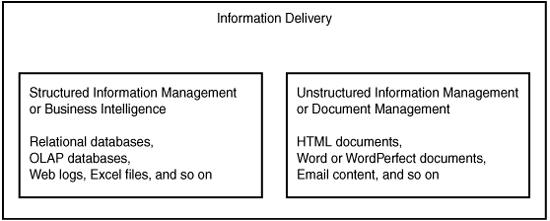
Industry analysts in the information delivery area regularly highlight the impressive adoption rates of BI products in the last few years as testimony to their value. The dynamic double-digit percentage growth rates for industry leaders like Business Objects are especially impressive when the difficult macroeconomic operating environment of recent years is taken into account. Ironically, many suggest, it is this same poor economic environment that has largely driven the increased worldwide demand for BI functionality as firms work to increase their productivity and competitiveness by leveraging existing investments—and doing more with less. This BI industry driver along with a few other drivers are covered in the next section.
Spectrum of Business Objects Product Usage
BI products like those distributed by Business Objects (Crystal Reports, Crystal Reports Server, BusinessObjects Enterprise, OLAP Intelligence, and WebIntelligence) are deployed and used in about as many different ways as there are product implementations—and there are millions. However, as you become exposed to a broad swath of BI clients and their implementations, you can find definite themes to their deployments. Taking a step back, distinctive drivers to worldwide BI product adoption become evident and a few of the most common are discussed in the following sections.
Custom Information Delivery Applications
Despite the increasing functionality of turnkey software and Web applications available today, corporations of all sizes still regularly look to custom developed applications to provide them with unique competitive advantage and to meet their proprietary business requirements. These applications run the gamut in size from small business applications through large departmental applications to enterprise intranet and extranet applications. The key component of these custom projects is the integration of BI functionality, such as formatted reporting, ad hoc query, self-service Web reporting, and/or analytic capabilities, within an internally developed application. Table 0.1 highlights some typical examples of custom applications using the Business Objects suite of products to help deliver custom applications.
Table 0.1. Sample Custom Information Delivery Applications

A key strength of the Business Objects suite of products is that it lends itself readily to integration into custom applications. From the inclusion of basic formatted reports within your Java/J2EE or .NET applications through the inclusion of rich ad hoc query and self-service reporting functionality in proprietary information product applications to provision of large-scale enterprise BI analytics, scheduling, and security functionality in a globally deployed application, the Business Objects suite of products can meet your requirements. Table 0.2 provides a jump-point for those looking for each type of application integration covered in this book.
Table 0.2. Custom Application Chapters Overview
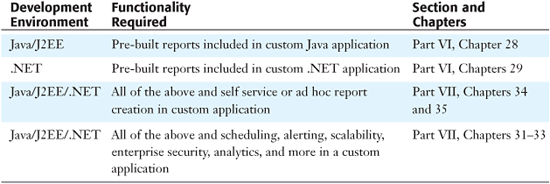
Enterprise BI Initiatives
With the proliferation of BI tools and the acceleration of product adoption around the globe, there has been concurrent pressure for the involved companies to standardize on a single set of products and tools—effectively a BI infrastructure or platform. The main arguments for such standardization include the following:
- Reduced total cost of product ownership
- Creation of Enterprise centers of excellence
- Reduced vendor relationships
- Movement toward a BI infrastructure/platform
As BI products have matured from different areas of historical strength and their marketplace acceptance has grown, end-user organizations have found themselves with disparate and incompatible BI tools and products across or even within the same departments in their organization. To eliminate the costliness of managing such a broad set of tools, many firms are now moving to adopt a single BI platform like BusinessObjects Enterprise (or Crystal Reports Server for smaller businesses). The infrastructure of BusinessObjects Enterprise provides a single architecture to manage all the content and tools required to serve an organization’s structured information delivery requirements. Figure 0.2 shows an end-user map of a typical organization. As you can imagine, each of the different types of end-users in a company requires different types of tools to be productive. A common infrastructure or centrally managed center of excellence such as BusinessObjects Enterprise that can meet all the varying end-user and IT requirements has clear organizational benefits.
Figure 0.2. Organizational end-user requirements map from Business Objects.

Details of the breakdown of this book are included later in this introduction but to jumpstart your learning on this type of BI application, Table 0.3 can point you to the sections and chapters of particular relevance now.
Table 0.3. Enterprise Business Intelligence Chapter Overview
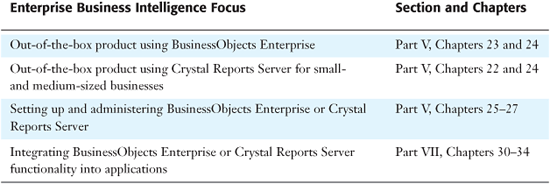
Enterprise Application Extension
In the past two decades, large firms have spent millions of dollars on enterprise applications including ERP and CRM applications such as SAP, Oracle/PeopleSoft, and Siebel. These large organizations are now looking for ways to extract analytic value from these operational data stores to facilitate organizational planning and forecasting through BI products.
The Business Objects suite of products includes a variety of specialized drivers that provide direct connectivity into these enterprise applications. It is important to note that these drivers are provided for use with the BusinessObjects Enterprise infrastructure and are usually released 3–6 months after the product suite is released. Chapter 15 introduces the drivers that were available at the time of publishing for this book for those who have an immediate interest in this topic.
Spectrum of BI Tool Users
Across the usage profiles of the thousands of BI scenarios/implementations, there generally exists a consistency in the types of people that become involved. Figure 0.3 provides a relatively high-level yet accurate graphic that shows a typical distribution of the people involved in BI implementations.
Figure 0.3. Average BI implementation user distribution.

Each of the three communities outlined in the pyramid plays a key role in the ongoing success and operation of any BI implementation. The content creators and system administrators play perhaps the most important role in ensuring the short- and long-term success of any deployment because it is their work to set up the system content and tools from which the other users derive benefit. The information analysts generally come from across an organization’s typical functions and are highly demanding users who require rich and highly functional interactive tools to facilitate their jobs as analysts. The last group is by far the largest group and includes employees, partners, customers, or suppliers who rely on the BI implementation to provide timely, secure, and reliable information or corporate truths. This group tends to span the entire corporate ladder from foot soldiers right up to the executive suite—all of whom have the same requirement of simple information provision to enable them to complete their regular day-to-day assignments successfully.
Figure 0.4 provides a schematic highlighting the distinction between the different V.XI content creation tools and the V.XI content delivery tools—BusinessObjects Enterprise, Crystal Reports Server, or Java/.NET Reporting engines. This book is essentially broken down into two halves covering these two themes—content creation (Parts I–IV) and content delivery in all of its possible forms (Parts V–VII) using the Business Objects suite of products.
Figure 0.4. Content creation and content delivery schematic.
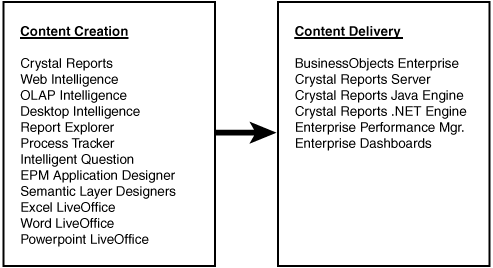
Content Creators (Information Designers)
Content creators provide the foundation to any BI implementation. Using content creation tools such as Crystal Reports, OLAP Intelligence (formerly Crystal Analysis), Web Intelligence, Desktop Intelligence (formerly BusinessObjects), Excel, and so on, this group of users—primarily composed of IT folks but sometimes complemented with technically savvy business users—creates the report content, dashboards, OLAP cubes, and reporting metadata that facilitates system usage and benefits derived from the other system users. Because these tasks are of paramount importance in a BusinessObjects Enterprise suite deployment, the entire first half of the book is dedicated specifically to providing these folks with a comprehensive tutorial and reference on content creation.
After content has been created, it needs to be distributed through an infrastructure such as BusinessObjects Enterprise, the new Crystal Reports Server product, or a custom application; and then, finally, it needs to be managed. Another small but critical group of BI system users—the BI administrators—need to ensure that the system is deployed and tuned correctly to ensure optimal performance for the business end-users. Chapters 25–27 provide a detailed guide to enable such administrators to effectively manage a BusinessObjects Enterprise system and the remaining chapters—28 through 35—provide detailed information on deploying Crystal content in a custom home-grown application.
Information Analysts
Although not the primary group in number, the information analysts in a BI deployment are those who are primarily responsible for the extraction of new business insights and actionable recommendations derived from the BI implementation. Using such analytic tools as Web Intelligence, Excel, OLAP Intelligence, and the Crystal Reports Explorer, this group of users spends their time interrogating, massaging, and slicing and dicing the data provided in the various back-end systems until nuggets of business relevance can be gleaned. These users tend to come from a wide variety of functional areas in a company including operations, finance, sales, HR, and marketing and all work with the provided BI tools to extract new information out of the existing corporate data set. Chapters 19–21 in Part IV provide detailed information on using both Web Intelligence, OLAP Intelligence, the LiveOffice plug-ins, and the Crystal Reports Explorer.
Information Consumers
This group of users composes the clear majority of those involved with a BI implementation. They are also the most diverse group and come from every rung on the corporate ladder. Executives who view corporate performance dashboards fit into this category as would truck drivers who receive their daily mileage and shipping reports online through a wireless device. The common characteristic of members of this group is that their interactions with the BI system are not indicative of their primary jobs. Unlike the content creators who are responsible for creating the valuable content and tools for the BI system and unlike the information analysts who are tasked with using the system to increase corporate performance, information consumers have jobs outside of the BI implementation and the key measure of success for them is that the BI system helps facilitate their variety of assignments. Chapters 21 through 23 provide overviews of the out-of-the-box BusinessObjects Enterprise and Crystal Reports Server interfaces. Because the number of interfaces can be as varied as the number of implementations, the final sections of the book (Parts VI–VII) provide you with the customization skills to provide your users with their perfect interfaces.
The Product Family from Business Objects
As Figure 0.4 showed, the Product family distributed by Business Objects is broken into two major segments, content creation and content delivery. This book is roughly split in two with each section covering one of the topics in great detail. The primary products in the family that are covered in these sections are Crystal Reports (first section) and Crystal Reports Server and BusinessObjects Enterprise (second section). The other complementary and specialized content creation products provided by Business Objects are introduced at the end of the first section of the book.
In the content creation section of the book, the following products will be introduced:
- Crystal Reports version XI—The world standard for professional formatted reporting across the largest spectrum of data sources. The Crystal Reports Application Designer benefits from more than 15 years of development and provides an unparalleled combination of powerful functionality and report-design flexibility.
- Web Intelligence XI—A powerful content creation tool designed to provide interactive, ad hoc querying functionality to users across the end-user spectrum. The drag-and-drop end user functionality is intuitive and leverages the best-of-breed semantic layer called Universes.
- OLAP Intelligence XI (formerly called Crystal Analysis)—A powerful content creation tool designed to access OLAP datasources and to provide interactive, speed of thought analytic reporting functionality to users across the end-user spectrum. The drag-and-drop design functionality is intuitive and the unique guided analytic functionality enables creation of content that brings the power of OLAP to the masses.
- LiveOffice add-ins for Excel, Word, and PowerPoint—Excel is the world’s most used BI tool. To enable Excel power users to remain in their familiar Excel interface, the Business Objects family includes a new integrated add-in for Excel, Word, and PowerPoint. These add-ins provide OLAP Cube exploration, powerful ad hoc report creation, and Report Part extraction from existing Crystal Reports. The new XI (release 2) product add-in enables end users to use existing Crystal Reports, Web Intelligence reports, or semantic layers as a data source for new ad hoc reports.
- Crystal Reports Explorer—Based on the Report Application Server object model and used with BusinessObjects Enterprise, this application provides designers with a subset of Crystal Reports Design capabilities over the Web in a DHTML interface. All the content created in this interface are Crystal Reports files.
- Universes and Business Views—The best-in-breed semantic layer (meta-layer) provided by Business Objects enables you to create a data abstraction layer for your report designers and/or business users. These tools provide dynamic SQL generation, access to multiple datasources, row- and column-level security, and so forth, and are available for use with BusinessObjects Enterprise.
- Desktop Intelligence XI—A powerful, client-installed ad hoc query and reporting tool designed to access existing Universes and to provide interactive, ad hoc reporting functionality to users across the end-user spectrum. The drag-and-drop design functionality is intuitive and leverages the best-of-breed Business Objects semantic layer. This product is the legacy BusinessObjects Report Designer tool (not to be confused with the Universe Designer). Using this tool is not covered in this edition of the book but BusinessObjects Enterprise XI release 2 enables distribution of these legacy reporting objects.
In the content delivery half of the book, the following Crystal Products and SDKs are covered:
- BusinessObjects Enterprise (formerly Crystal Enterprise)—A complete end-to-end BI and Enterprise Reporting Platform that provides the infrastructure to support a range of implementations from small internal projects to global extranet deployments supporting tens of thousands of users. BusinessObjects Enterprise provides a wealth of Enterprise functionality including scheduling, security, auditing, alerting, and so on through several turnkey interfaces. Additionally, the functionality of BusinessObjects Enterprise can be embedded in your custom applications through use of its completely open Java and .NET object models and UI code.
- Crystal Reports Server—New to version XI, Crystal Reports Server provides all the functionality of BusinessObjects Enterprise but is limited to a single multi-CPU server, does not include the ability to distribute non–Crystal Reports content and is aggressively priced for small- and medium-sized businesses. The majority of content in the book discussing BusinessObjects Enterprise also applies to Crystal Reports Server and is a very attractive option for deploying BI and reporting solutions.
- Crystal Vision—New to version XI release 2, Crystal Vision provides a combination of the functionality of Crystal Reports Server with the newly acquired Crystal Exelcius dashboarding functionality.
- Crystal Reports Engine for .NET Applications—The only third-party tool distributed with Visual Studio .NET, this reporting component enables .NET developers to quickly embed limited but powerful reporting functionality into their .NET applications.
- Crystal Reports Engine for Java Applications—Embedded in Borland’s JBuilder and other Java IDEs, this reporting component enables Java developers to embed limited but powerful reporting functionality into their Java applications quickly.
- Report Application Server—No longer a separate product on its own, the Report Application Server (formerly called Crystal Enterprise Embedded in v10), provides a multithreaded object model and scalable server on the BusinessObjects Enterprise (and Crystal Reports Server) infrastructure. This server provides both Java and .NET developers with access to the power of the Crystal Reports design and modification APIs for integration into their custom applications.
- Enterprise Performance Management for BusinessObjects Enterprise (formerly called Application Foundation)—A powerful extension to the BusinessObjects Enterprise, this product consists of dashboarding, scorecarding, and advanced analytic functionality. These tools enable you to deliver aggregated visualizations of your key performance metrics and provide drill-down into associated reports (for instance, Crystal Reports). Using these tools is not covered in this edition of the book but they are available from Business Objects for extending your BusinessObjects Enterprise system.
What Is in This Book
This book is broken down into several sections to address the varied and evolving requirements of the different users in a BI deployment.
The entire first half of the book (Parts I through IV) is exclusively focused on content creation. Through use of hands-on step-by-step examples and detailed descriptions of key product functionality, you will be able to leverage the powerful report creation capabilities of Crystal Reports V.XI, Web Intelligence, OLAP Intelligence V.XI, Business Views and Universes, the Web-based Crystal Reports Explorer, and the LiveOffice Ad Hoc add-in. Some profiles of people who will find these sections of particular relevance:
- New and mature Crystal Reports designers
- Professional Crystal Reports designers upgrading to V.XI
- Existing and new OLAP Intelligence, Web Intelligence, and Desktop Intelligence (formerly Business Objects) designers and analysts
- Existing and new BusinessObjects Enterprise (formerly Crystal Enterprise) administrators
- New Crystal Reports Server administrators
The second half of the book (Parts V through VII) is geared toward the distribution or delivery of the valuable content created in the first half. Detailed functionality overviews are provided for all the different distribution mechanisms available in the Business Objects suite of products. Additionally, detailed and instructive code samples are provided for all the Software Development Kits (SDKs) that are provided with Crystal Reports, BusinessObjects Enterprise, and the Crystal Reports Server. Some profiles of people who will find these sections of high value:
- New or existing BusinessObjects Enterprise (formerly Crystal Enterprise) administrators
- New or existing BusinessObjects Enterprise (formerly Crystal Enterprise) users
- .NET-based application developers
- Java/J2EE-based application developers
- Application developers looking to integrate report design or modification into their applications
- Application developers looking to integrate report scheduling, security, alerting, viewing, and so on into their applications
Part I: Crystal Reports Design
Part I should familiarize you with the foundations of Crystal Reports and get you up and running as quickly as possible. It is critical for someone who is new to Crystal Reports and includes the fundamental report-design concepts that even experienced users will be able to use for the rest of their Crystal Reports writing career. This section also provides powerful exercises and real-world usage tips and tricks that will enable even seasoned reporting experts to become more productive.
Part II: Formatting Crystal Reports
Part II focuses on some of the more subtle nuances of Crystal Report design: effective report formatting and data visualization through charting and mapping. Improper formatting and incorrect use of visualization techniques can make reports confusing and not user-friendly. This section also provides powerful exercises and real-world usage tips and tricks enabling mature reporting experts to become more productive.
Part III: Advanced Crystal Reports Design
Part III presents a host of advanced Crystal Report design concepts that involve features such as subreports, cross-tabs, report templates, and alerts. This part also touches on advanced data access methods such as Javabeans, XML objects, SAP, and Peoplesoft systems. This section also provides powerful exercises and real-world usage tips and tricks enabling mature reporting experts to become more effective in their report-design work.
Part IV: Enterprise Report Design—Analytic, Web-Based, and Excel Report Design
Part IV focuses on a the powerful Web Intelligence and OLAP Intelligence design tools for ad hoc querying and analysis against both relational and OLAP data sources. Chapter 18 also covers the semantic layer (Business Views and Universes), the reporting Repository, and both the Web- and Office-based Crystal ad-hoc reporting capabilities.
Part V: Web Report Distribution—Using BusinessObjects Enterprise Professional and Crystal Reports Server
Part V presents the powerful functionality of the turnkey BI and Enterprise reporting product—BusinessObjects Enterprise (and Crystal Reports Server). In addition to covering the many business benefits of these systems, this part also provides extensive coverage of the end-user interface for end-user training. Extensive architecture, administration, and management best practices are provided for system administrators.
Part VI: Customized Report Distribution—Using Crystal Reports Components
Part VI focuses on the Customizable Report Distribution Components that are provided for Crystal Reports Delivery in both the .NET and Java/J2EE worlds. Code samples are provided to help jumpstart your development work.
Part VII: Customized Report Distribution—Using BusinessObjects Enterprise and Crystal Reports Server
Part VII provides a detailed look into the object model of the BusinessObjects Enterprise and Crystal Reports Server systems through Java code samples and tutorials (.NET samples also available). All the functionality described in Parts V and VII is included in this rich object model and allows developers to quickly include the powerful functionality of BusinessObjects Enterprise, Crystal Reports Server and Crystal Reports in their custom applications.
Equipment Used for This Book
You can find various supporting material that will assist you in the completion of the exercises in this book, as well as supplemental documentation on related topics. You should have access to a computer that has at least a 450MHz Pentium II or equivalent processor, 128MB of RAM, and Windows 2000, Windows 2003, or Windows XP Professional.
Web Resources
You can find all the source code and report samples for the examples in the book, as well as links to great external content, at www.usingcrystal.com. You’ll find report samples to download and code for you to leverage in your report design and sharing efforts. Also, a great deal of additional product-related information on the Business Objects suite of products including Crystal Reports, Web Intelligence, OLAP Intelligence, Desktop Intelligence, Crystal Reports Server, and BusinessObjects Enterprise can be found at www.businessobjects.com.
Intended Audience
This book was written to appeal to the full range of Crystal Reports, OLAP Intelligence, Web Intelligence, Crystal Reports Server, and BusinessObjects Enterprise users. You’ll find this book useful if you’ve never used the Business Objects suite of products before, if you are a mature Crystal Reports user looking for some new productivity tips, or if you want to explore some of the new features found in version XI and their related SDKs.
You don’t have to be an expert, but you should have a basic understanding of the following concepts:
- Database systems such as Microsoft SQL Server, Oracle, Sybase, and Informix
- Operating system functions in Windows 2000/2003/XP
- General Internet/intranet-based concepts such as HTML, DHTML, ActiveX, and Java
The first four parts of this book build on each other, so skipping around those parts isn’t the best approach unless you have some familiarity with Crystal Reports XI. Even if you are familiar with Crystal Reports, many new features have been introduced in recent versions, so you are encouraged to read the entire first half of the book so that you don’t miss anything. The second half of the book is focused on the different forms of content delivery and each part can be approached independently without loss of context.
Requirements for This Book
To get the most from this book, you should have access to a computer that has at least a 450MHz Pentium II or equivalent processor, 128MB of RAM, and Windows 2000, Windows 2003, or Windows XP Professional.
All reports are based on sample data that is installed with Crystal Reports, so you will have access to the same data that was used in this book. You’ll need to install Crystal Reports to get the most out of the examples included in each chapter in the first half of the book.
Conventions Used in This Book
Several conventions are used within this book to help you get more out of the text. Look for special fonts or text styles and icons that emphasize special information.
- Formula examples appear in computer type, and they can be found on the Sams Publishing website as well.
- Objects such as fields or formulas normally appear on separate lines from the rest of the text. However, there are special situations in which some formulas or fields appear directly in the paragraph for explanation purposes. These types of objects appear in a special font like this:
Some Special Code. - In some cases, we might refer to your computer as machine or server. This is always in reference to the physical computer on which you have installed Crystal Reports.
- You’ll always be able to recognize menu selections and command sequences because they’re implemented like this:
Use the File, Open command. - New terms appear in italics when they are defined.
- Text that you are asked to type in appears in boldface.
- URLs for websites are presented like this: http://www.businessobjects.com.
Notes help you understand principles or provide amplifying information. In many cases, a note emphasizes some piece of critical information that you need. All of us like to know special bits of information that make our job easier, more fun, or faster to perform.
Tips help you get the job done faster and more safely. In many cases, the information found in a tip is drawn from experience rather than through experimentation or documentation.
Real World sections provide some practical and productivity enhancing usage insights derived from the author’s real-world experience designing and deploying hundreds of Crystal Reports.
Troubleshooting sections provide some quick chapter summary notes and examples that are useful reminders on the product operations.
